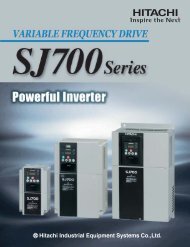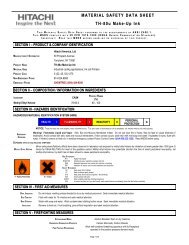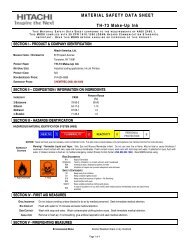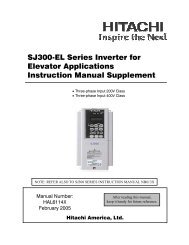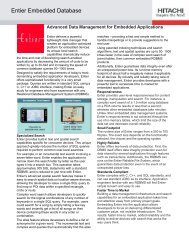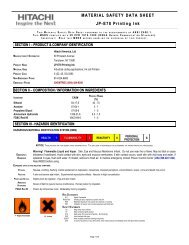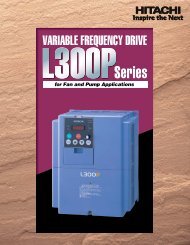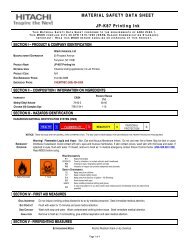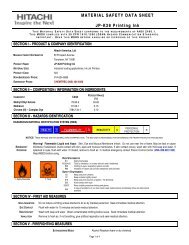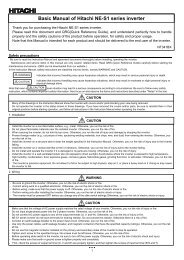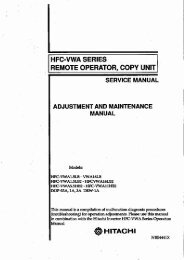SJ700-2 Instruction Manual NT204DX - Hitachi America, Ltd.
SJ700-2 Instruction Manual NT204DX - Hitachi America, Ltd.
SJ700-2 Instruction Manual NT204DX - Hitachi America, Ltd.
You also want an ePaper? Increase the reach of your titles
YUMPU automatically turns print PDFs into web optimized ePapers that Google loves.
Chapter 4 Explanation of Functions<br />
4.2.96 Sensorless vector control<br />
The sensorless vector control function estimates and controls<br />
the motor speed and output torque on the basis of the inverter<br />
output voltage and output current and the motor constants set<br />
on the inverter. This function enables the inverter to accurately<br />
operate the motor with a high starting torque, even at a low<br />
frequency (0.3 Hz or more).<br />
To use this function, specify "03" for the V/F characteristic curve<br />
selection (A044/A244).<br />
Before using this function, be sure to make optimum constant<br />
settings for the motor with reference to Section 4.2.91, "Motor<br />
constant selection."<br />
When using this function, observe the following precautions:<br />
1) If you use the inverter to drive a motor of which the capacity<br />
is two classes lower than the maximum applicable capacity<br />
of the inverter, you may not be able to obtain adequate<br />
motor characteristics.<br />
2) If you cannot obtain the desired characteristics from the motor driven under the sensorless vector<br />
control, readjust the motor constants according to the symptom, as described in the table below.<br />
Operation<br />
status<br />
Symptom Adjustment method Adjustment item<br />
Powering<br />
Momentary speed Increase the motor constant R2 step by step from the<br />
H021/H221/H031<br />
variation is negative. set value up to 1.2 times as high as the set value.<br />
Momentary speed Reduce the motor constant R2 step by step from the set<br />
H021/H221/H031<br />
variation is positive. value down to 0.8 times as high as the set value.<br />
Regenerating<br />
Increase the motor constant R1 step by step from the<br />
Torque is insufficient at<br />
H020/H220/H030<br />
set value up to 1.2 times as high as the set value.<br />
low frequencies<br />
Increase the motor constant Io step by step from the set<br />
(several Hz)<br />
H023/H223/H033<br />
value up to 1.2 times as high as the set value.<br />
Starting<br />
The motor generates an<br />
Reduce the motor constant J from the set value.<br />
impact when it starts.<br />
H024/H224/H034<br />
Decelerating<br />
The motor runs Reduce the speed response setting.<br />
H005/H205<br />
unsteadily. Reduce the motor constant J from the set value. H024/H224/H034<br />
Torque is insufficient<br />
Torque-limited during torque-limited Reduce the overload restriction level to lower than the<br />
operation operation at a low torque limiter level.<br />
b021, b041 to b044<br />
frequency.<br />
Low-frequency Motor rotation is<br />
operation inconsistent.<br />
Increase the motor constant J from the set value. H024/H224/H034<br />
starting<br />
Motor runs backwards<br />
for short moment.<br />
Set 01 (enable) on reverse run protection function<br />
(b046)<br />
Related code<br />
A001: Frequency source setting<br />
A044/A244: V/F characteristic curve selection,<br />
1st/2nd motors<br />
F001: Output frequency setting<br />
b040: Torque limit selection<br />
b041 to b044: Torque limits (1) to (4)<br />
H002/H202: Motor data selection, 1st/2nd motors<br />
H003/H203: Motor capacity, 1st/2nd motors<br />
H004/H204: Motor poles setting, 1st/2nd motors<br />
H005/H205: Motor speed constant, 1st/2nd<br />
motors<br />
H020/H220: Motor constant R1, 1st/2nd motors<br />
H021/H221: Motor constant R2, 1st/2nd motors<br />
H022/H222: Motor constant L, 1st/2nd motors<br />
H023/H223: Motor constant Io, 1st/2nd motors<br />
H024/H224: Motor constant J, 1st/2nd motors<br />
H050/H250: PI proportional gain, 1st/2nd motors<br />
H051/H251: PI integral gain, 1st/2nd motors<br />
H052/H252: P proportional gain setting, 1st/2nd<br />
motors<br />
Note 1: Always set the carrier frequency (b083) to 2.1 kHz or more. If the carrier frequency is less than 2.1<br />
kHz, the inverter cannot operate the motor normally.<br />
Note 2: When driving a motor of which the capacity is one class lower than the inverter, adjust the torque<br />
limit (b041 to b044) so that the value "α" calculated by the expression below does not exceed<br />
200%. Otherwise, the motor may be burnt out.<br />
α = "torque limit" x (inverter capacity)/(motor capacity)<br />
(Example) When the inverter capacity is 0.75 kW and the motor capacity is 0.4 kW, the torque<br />
limit value is calculated as follows, based on the assumption that the value "α" should<br />
be 200%:<br />
Torque limit (b041 to b044) = α x (motor capacity)/(inverter capacity) = 200% x (0.4<br />
kW)/(0.75 kW) = 106%<br />
b046<br />
4 - 90



